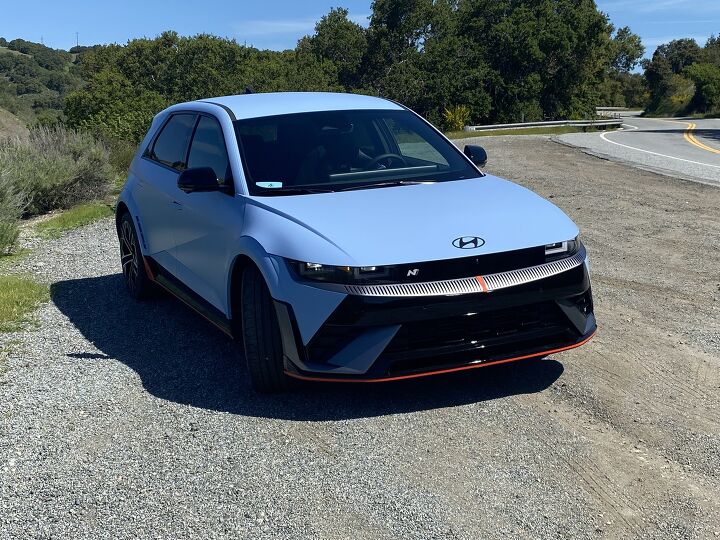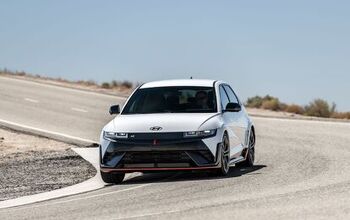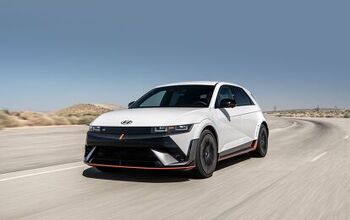2025 Hyundai Ioniq 5 N Review – Shockingly Spicy

I wouldn’t expect most crossover-ish hatchbacks to be solid track machines. Especially if they’re carrying the weight of an electric-vehicle battery.
So imagine my surprise at the relative capability of the 2025 Hyundai Ioniq 5 N as I hustled it around the famous Laguna Seca racetrack near Monterey, California.
“Relative” is a key word – the Ioniq 5 N is good on the track, but it’s not for everyone. The on-street experience may be too high strung for commuters and there are some drawbacks in terms of battery life that need to be factored in – but we will get to that.
(Full disclosure: Hyundai flew me to Monterey/Carmel, California and fed and housed me. They also offered a tire inflator, pen, and notebook that I took home, and a hat that I did not.)
First, here’s how Hyundai has differentiated the N from its more-mainstream sibling.
Since it’s designed for track use, the N version of the Ioniq 5 is longer, lower, and wider than the mainstream Ioniq 5. It’s a hair over 3 inches longer, 2 inches wider, and a bit less than an inch lower. Ground clearance for both the car overall and the battery itself drop half an inch. Even the seating position gets lowered. Torsional rigidity is also increased.
Mechanical bits meant to improve performance include an integrated drive axle; special performance Pirelli P Zero tires; a tweaked suspension (MacPherson strut in front, multi-link in the rear); and a rack-type, motor-driven system for the power steering. The cooling system is beefed up with an added upper radiator grille – and the system has separate cooling for the battery and the electric motors. Heat exchanging is improved compared to the 5 and the oil cooler and battery chiller have increased capacity.
Torque is biased towards the rear, 70/30, and there’s a rear electronically controlled limited-slip differential. You can even drift this rig – a Hyundai executive put on a tire-eating parking lot show during lunch.
Aero bits include active air flaps, rear spoiler, rear diffuser, side skirts, front and rear wheel deflectors, and undercovers for most of the undercarriage.
Hyundai structured this drive to give us enough track time to get a sense of the N’s different performance/drive-mode settings. The 4,861-pound curb weight is noticeable but manageable – there’s enough power on hand to get you going, and while you will feel how heavy the Ioniq 5 N is during your track laps, the chassis is tuned well enough that you’ll still have fun.
It was my first time at Laguna Seca, so I fumbled around a bit, but once I got enough sense of the line I was able to push fairly hard. Understeer is present when you’re pushing hard, though not obnoxious. Similarly, body roll showed up during intense cornering.
Turn-in was sharp and accurate and the steering felt well-weighted. Having 601 horsepower and 545 lb-ft of torque – up to 641 hp/568 lb-ft when the N Grin Shift button is pressed, more on that later – provided by the front and rear electric motors lets you make relatively short work of straightaways. The brakes were stout and consistent with no fade – for reference my session was mid-morning on a warm day, and I had three consecutive three-lap runs with a cooldown lap each time and a few minutes break in between.
For those curious how the power numbers split among the electric motors, the front has 223 ponies and 258 lb-ft (235/273 when using N Grin) and the rear is 378/288 – 406/295 when using boost.
Hyundai has given drivers of the N the ability to make it feel like an internal-combustion engine vehicle. That means fake exhaust sounds, paddle shifting for the “gears”, the whole works. Hyundai branding for these systems is N Active Sound+ and N e-Shift.
I am generally skeptical of fake exhaust sounds when it comes to EVs, but on track, this application sounded pretty good. There may be some psychology at work – making the unfamiliar feel and sound familiar, or something like that – but I enjoyed it. I also found that shifting the “gears” with the paddles wasn’t all that different from driving an ICE car – you needed to upshift and downshift to put the vehicle in the proper “gear” for each corner, just like we’ve always done. You even feel the shifts in your derriere, and there’s a handy light in the dash that comes on when you hit the “rev limiter”.
That is, if you choose to use the paddles – like with any automatic-transmission ICE vehicle, you could just drop it into Drive and let it do all the work for you. Just for reference, the transmission setup here is single-speed reduction gear with shift-by-wire.
The biggest difference here is that while there is, of course, regenerative braking, the system doesn’t really engine brake the way an ICE car would. Because, obviously, it’s not an ICE vehicle. Regenerative braking gives you some of that feeling, but it’s not the same.
Pushing the N Grin Boost will give you additional power for up to 10 seconds. A neat track trick, right? Like push-to-pass in IndyCar? Yes, but there’s a catch – if you’re using the paddles manually, engaging the NGB system will drop it back into automatic mode. I found this out the hard way at speed with the Turn 2 hairpin rapidly approaching. You must click the right-side paddle to reengage manual mode, but when you do, it will be in too high a “gear”, so you’ll have to “downshift” with the left paddle very quickly. Finding this out, at speed, on an unfamiliar track, will cause one to lose a lot of speed while trying to get the settings correct.
I asked Hyundai if the system could be set to simply return to manual mode when NGB is done, and they said that it could be changed with an over-the-air update. We’re living in the future, my friends.
All this gimmickry is fun and makes the on-track experience feel (mostly) familiar, but really, it’s about vibes. This is still an EV and still behaves like it, for better and worse. You can trick your brain into thinking you're driving an ICE vehicle, but you aren’t.
Because you are in an EV, you get instant acceleration response, a lower center of gravity, and the extra weight of the battery.
On street, the Ioniq 5 feels a bit high strung, but that’s mostly because the e-Shift and Active Sound systems were still in use. They can be shut off, and I would advise doing so when you’re not on the track. Let your EV be an EV when commuting.
Otherwise, ride and handling over a local mountain road was just as fun as on track, and the slower speeds kept understeer and body roll at bay. As good as the Ioniq 5 N is on track, it also shines on the back roads.
That said, the street drive was kept short – we had other stuff to do, check back later this week – so I don’t have a ton of detail to report. I look forward to living with one for a week and doing some light-duty suburban driving.
If you’re wondering how the 84-kWh lithium-ion battery held up during track use, the charge dropped about 30 percent during my session. I started with around 85 percent and finished with about 57 – and the vehicle was left “on” during our short rest breaks. So that’s where it stood after one warm-up lap, about nine “flying” laps, three cooldown laps, and two 10-minute rest periods. Hyundai is claiming that the car can go from 10 to 80 percent charge in 18 minutes when using 800V charging. On the Level 2 you might have at home, the full charge time is 7 hours and 20 minutes. Range is about 221 miles and the battery can preconditioned, including for track use.
The interior isn’t neglected – Hyundai gives the N a unique steering wheel with buttons for all the various N modes and settings. The digital gauge cluster and infotainment system sit in the same dash panel with 12.3-inch screens for each sitting side-by-side. You get metal pedals, sport bucket seats with manual adjustment, and a padded center console. Cosmetic exterior changes include a unique rear bumper with the aforementioned diffuser, checkered-flag rear reflector lights, a triangle-shaped center high-mounted stop light, special 21-inch wheels, and unique badging.
The cabin is comfortable though the fake sounds come through quite loudly. Wind/road noise seemed well muted, even during track attacks.
All this doesn’t come cheap – and we haven’t mentioned non-performance comfort, convenience, and safety features yet. Available features in those categories include Bose audio, wireless Apple CarPlay and Android Auto, performance data in the infotainment system (lap times and such), highway driving assist, digital key, rear occupant alert, forward collision-avoidance assist, and blind-spot monitoring systems.
When it’s all added up, this version of the Ioniq 5 will set you back $66,100, plus destination.
Hyundai wouldn’t give us a target for sales numbers. That might be company policy across the board, but also, I think Hyundai doesn’t really know how this vehicle will do. That’s just a guess on my part, no one from Hyundai told me that on or off record, at least that I can recall. Hyundai is playing it close, I think, because the company is stepping into an unknown here. There aren’t a ton of pure performance EVs yet – a few, but not many – and this one is based on a hatchback utility vehicle. So, who’s the target buyer?
Hyundai told us that perhaps he or she is a performance enthusiast who is EV hesitant. That may be. Other Hyundai folk said the buyer might be someone who wants to go to the track without sacrificing cargo space and utility. Sure, why not?
I doubt Hyundai would spend the development costs without having some idea of a target buyer. I also doubt Hyundai is going to sell a ton of Ioniq 5 Ns – the regular Ioniq 5 is very good, very comfortable on-road, and a lot cheaper.
Maybe that’s OK. We live in a world of optimization – there aren’t as many small-volume niche sports models on the market, it seems, as there was just a decade or two ago. All because, with a few notable and well-known exceptions, OEMs tend to avoid models that will sell in small numbers but make enthusiasts happy.
Maybe we don’t need to optimize every model. There’s a place for high-performance models that don’t sell in big numbers but make a big impression. It seems Hyundai recognizes that.
What matters most, to me and, I suspect, to most enthusiasts, is that the brand didn’t just cynically slap some badging on the Ioniq 5, make some minor suspension adjustments, and call it a day. I have no idea if the Ioniq 5 N will resonate with the public, let alone sell well, but I applaud Hyundai’s effort and execution here.
If our performance future is electric, consider this spiced-up utility vehicle a shockingly strong step in the right direction.
[Images © 2024 Tim Healey/TTAC.com]
Become a TTAC insider. Get the latest news, features, TTAC takes, and everything else that gets to the truth about cars first by subscribing to our newsletter.

Tim Healey grew up around the auto-parts business and has always had a love for cars — his parents joke his first word was “‘Vette”. Despite this, he wanted to pursue a career in sports writing but he ended up falling semi-accidentally into the automotive-journalism industry, first at Consumer Guide Automotive and later at Web2Carz.com. He also worked as an industry analyst at Mintel Group and freelanced for About.com, CarFax, Vehix.com, High Gear Media, Torque News, FutureCar.com, Cars.com, among others, and of course Vertical Scope sites such as AutoGuide.com, Off-Road.com, and HybridCars.com. He’s an urbanite and as such, doesn’t need a daily driver, but if he had one, it would be compact, sporty, and have a manual transmission.
More by Tim Healey
Latest Car Reviews
Read moreLatest Product Reviews
Read moreRecent Comments
- Lorenzo If it's over 30 years old and over 80k miles, and not a classic, it's a parts car, worth no more than 20% of original price.
- Dusterdude No mileage noted on a 33 year old car means likely well north of 300k + miles , along with issues noted , should equate to an ask price of less than $3k
- Ajla IMO, something like this really should be naturally-aspirated.
- Kjhkjlhkjhkljh kljhjkhjklhkjh Unless they are solid state batteries you BAN THEM. I like EVs... but EVs like to burn ... for days
- Kjhkjlhkjhkljh kljhjkhjklhkjh uh .. it looks like a VW golf got the mumps
















































Comments
Join the conversation
"If" our performance future is electric"??? Make no mistake..it is. There are a plenty of examples of performance EV's that beat the crap out of most ICE cars. My Kia EV6 GT will beat most cars on the road in a straight line (11.3 s 1/4 mile- best pass). This is only the beginning. When a Tesla Plaid, at around $73K used can beat most dedicated races cars...the future is upon us. Why fight it.
An almost 5000 pound hot hatch that fell out of the ugly tree and hit every branch on the way down? No thanks.